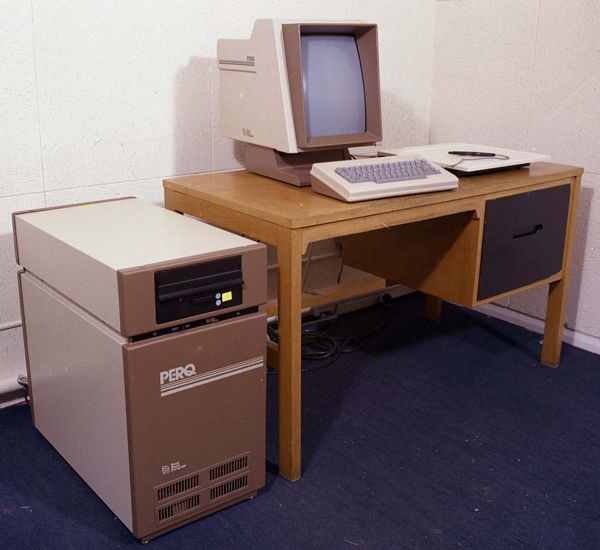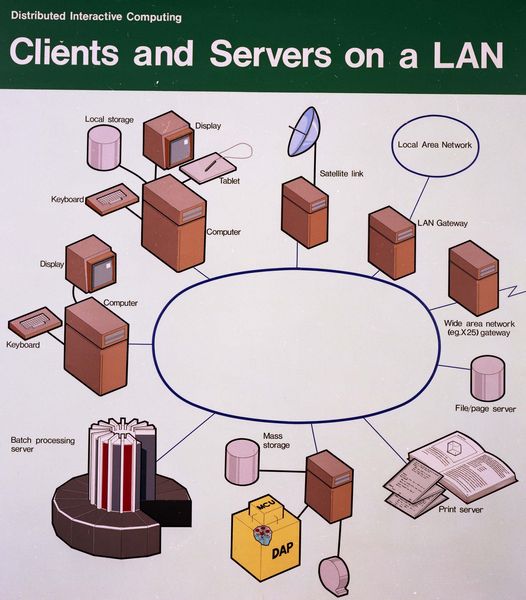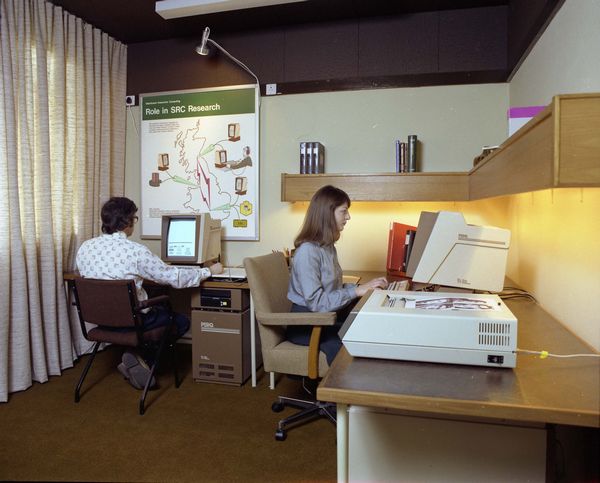

There have been enormous advances in the scales and techniques of using computers over the last 20 years. In the early days, computers ran a single job at a time. The first major breakthrough was multiprogramming, which permitted many jobs to share the resources of a single large system. The main reasons for this approach were (1) the need to utilize expensive resources to the maximum (large computers being cost-effective only so long as they did not stand idle) and (2) advances in software which resulted in the concept of a supervisory program or operating system to schedule the resources of the system.
Timesharing. In the 1970's, the second major advance in computing was the development of interactive systems, which allowed many users to access a computer so that the computer appeared to be their own private system. Unlike multiprogramming, where jobs were placed in a queue to be run later, the user was able to develop programs at a terminal and to interact with a program that was executing. With the ability to input and output graphical information as well as text, large-scale computer-aided-design systems developed. Interactive timesharing appeared, partly because new software concepts such as paging and virtual memory allowed efficient operating systems to be developed, but also because technological advances such as large memories made interactive timesharing economical. Even in the 1970's, it was generally too expensive to allow a single user sole access to a computer system except in very special circumstances. When many users access a single system, they can share programs and data. This is particularly beneficial when many users are collaborating on or are involved in a single project.

Single-user systems. In the last few years, a number of hardware and software advances have made possible a third major change in computer usage. A single-user system, such as that shown in Figure 1, is now an economically viable way of providing computer power. Advances in networking and local communications make it possible for these single-user systems to be interconnected, thereby retaining all the advantages of the large mainframe in terms of program- and data-sharing. This concept of distributed interactive computing (illustrated in Figure 2) will have a profound effect on computing advances in the 1980's.

Xerox PARC Alto. About six years ago, the Xerox Palo Alto Research Center developed a single-user system called the Xerox PARC Alto. These systems were linked to form a powerful research facility, which demonstrated that a single-user system located in a researcher's office could give significant benefits over modem time-sharing systems. The terminal could take the place of many of the functions in a conventional office, including the desk and mail service, and allowed a mode of working which was richer and more flexible than that available through conventional time-sharing systems. The Xerox development allowed increased scientific productivity, although it was a research project and commercially uneconomical at the time.
Specification of a single-user system. The main components of a single-user system are as follows:

Technological improvements. Three years ago, a system with these characteristics could not be purchased at a cost less than £70,000. Since then, there have been a number of significant advances which now make such systems economically viable:
These technological advances mean that single-user systems can be built and marketed within the cost given above. In addition, many of the technological advances are still in an early stage so that decreases in cost or increases in functionality at the same cost are likely in the near future.
In May 1979 the Three Rivers Computer Corporation of Pittsburgh announced the PERQ personal computer system, which had all the above major characteristics of an economically viable single-user system (Figure 3). In June 1979 the company took its very first order from the UK's Rutherford Appleton Laboratory. Three Rivers was a small company that had previously specialized in the production of high-quality graphics equipment. The PERQ development was headed by Brian Rosen, who had worked at Carnegie-Mellon University and Xerox PARC. PERQ was officially launched in August 1979 at Siggraph in Chicago, where the prototype was demonstrated. In 1979 it was clear that a commercially available single-user system, at a reasonable price, would eventually have a significant effect on the world computer market and have an immediate effect on the UK research scene, which is the province of the UK Science and Engineering Research Council. SERC funds a large fraction of British university research (like NSF in the US) as well as its own laboratories, such as Rutherford Appleton.
In 1979 it was also clear to SERC that one small US computer company could not cope with the worldwide demand for single-user systems, let alone the subsequent after-sales service. Thus in August 1981 the UK's largest computer company, International Computers Limited, formally entered into commercial cooperation with Three Rivers, giving the two companies worldwide manufacturing and marketing coverage. ICL began UK production of the PERQ in January 1982. The first customers to receive PERQs were the two institutions whose research programs have influenced PERQ developments - Carnegie-Mellon in Pittsburgh and Rutherford Appleton in England. A strong Anglo-American partnership has developed between the two companies and the two research laboratories.
PERQ is a high-powered, single-user computer system with a high-precision display providing a significant improvement in the quality and speed of interaction. Its main features are the following:
SERC runs several major national coordinated research projects in computer science and computing-intensive engineering research. All of these programs are being affected by the advent of single-user systems and distributed interactive computing.
The Distributed Computing Systems programme. Since 1977, DCS has been concentrating on the problems of linking a number of processors to form a coherent computer system. The effort has involved some 40 projects throughout the UK which have, until recently, based their research on cheap, low-power systems (having only some of the desired single-user-system characteristics), usually connected by a 10M-bit-per-second Cambridge Ring local area network. The arrival of the PERQ is enabling the DCS community to build high-performance, highly interactive distributed systems.
The Interactive Computing Facility. The ICF is a national network of multi-user minicomputers, such as the Prime 750, connected by the SERC's X.25 wide area network. Each minicomputer provides interactive graphics, based on vector-refresh displays and storage tubes, to a local community of engineering researchers. The network links about 2000 researchers to various major central resources (such as large mainframes) as well as providing the inter-person links so vital to national coordination and cooperation. The ICF is now moving to PERQ single-user systems to improve the speed and quality of its interactive graphics facilities.
The Software Technology Initiative. SERC has recently launched a national, coordinated initiative to improve its software technology. This new programme is based on a large number of PERQ single-user systems networked across the UK.
The above research programmes illustrate SERC's role, a role that spreads across all scientific disciplines. Increasingly, the computing needs of most scientists, not just computer scientists, are converging toward the networked single-user-system approach for interactive use. Thus SERC has decided to build its national computing strategy for the 1980's around a common set of hardware and software facilities to
The common facilities base may be crudely schematized as follows:
Pascal and Fortran are the two most popular and portable scientific programming languages. The common-base Pascal is the forthcoming International Standards Organization standard and the Fortran choice is Fortran 77. GKS (Graphics Kernel System) is due to become the ISO standard graphics package later in 1982. UNIX has been chosen as the common-base operating system because of its widespread popularity and availability and its suitability for interactive usage. PERQ is seen currently as the best commercially available single-user system. The Cambridge Ring local area network to interconnect PERQs is widely available from several manufacturers, is already installed in perhaps half the UK universities, already connects to a variety of minicomputers, and, at 10M bits per second, is state of the art in speed terms. X.25 has been chosen for the wide area network, since SERC already has its own private, national X.25 network, which is compatible with the recently announced X.25 public service from British Telecom, the national postal, telegraph, and telephone authority. The next generation of networking is already under development, with Cambridge Rings of seven sites currently being connected via satellite (see Figure 2).
The development of the common base is being led by SERC's Rutherford Appleton Laboratory in association with the UK universities. In particular, Three Rivers Computer, ICL, RAL, and Carnegie-Mellon University's Spice project are cooperating to move Unix to PERQ. RAL is currently transporting Unix Version 7 to PERQ to run on top of the Spice project's Accent Kernel to give PERQ a 32-bit paged Unix system. The target completion date as of this writing was June 1982.
The common-base policy should allow UK researchers to share the benefits of each others' work quickly and easily. Existing technology will be moved from a variety of disparate hosts into the common base; already in the pipeline are Ada, Prolog, the Gaelic circuit-design package, the Dragon drafting package, real-time data-capture facilities, and office automation.
The appearance in the marketplace of inexpensive, high-powered, single-user systems with good interactive capabilities via high-precision displays has enabled the UK's Science and Engineering Research Council to launch a major initiative to exploit computer technology. SERC is implementing a common-base policy aimed at providing a national network of over 200 single-user systems (based initially on the PERQ computer) throughout the British universities by the end of 1983.
F.R.A. Hopgood is head of the Computing Division of the Rutherford Appleton Laboratory in England. He also holds a part-time chair at Brunel University in the Department of Computer Science. Previous to this he worked at the Atomic Energy Research Establishment, Harwell, and the Atlas Computer Laboratory. He has written a book on compiling techniques and over the last few years has been very active in the British group working on graphics standards.
Hopgood is currently vice-chairman of Eurographics and a member of the British Computer Society Council. He received his BA and MA degrees in mathematics in 1959 and 1961, respectively, at Cambridge University.
Robert W. Witty is manager of the Distributed Interactive Computer Section of the Rutherford Appleton Laboratory's Computing Division and coordinator of SERC's Software Technology Initiative. From 1970 to 1975 he worked for British Petroleum's Computer Department. He then joined the Microfilm Graphics Project at SERC's Atlas Computer Laboratory. After two years he became coordinator of SERC's Distributed Computing Systems Programme, based at RAL. His research interests include software design and representation techniques and the application of formal methods in software engineering.
Witty received a B.Tech in computer science and a PhD in software engineering, both from Brunel University.